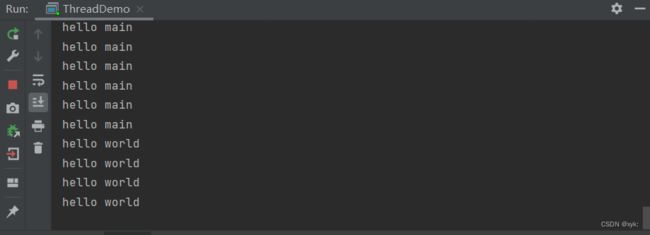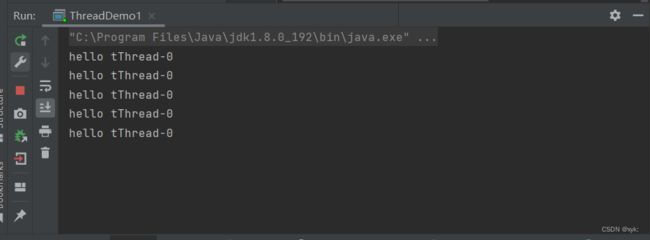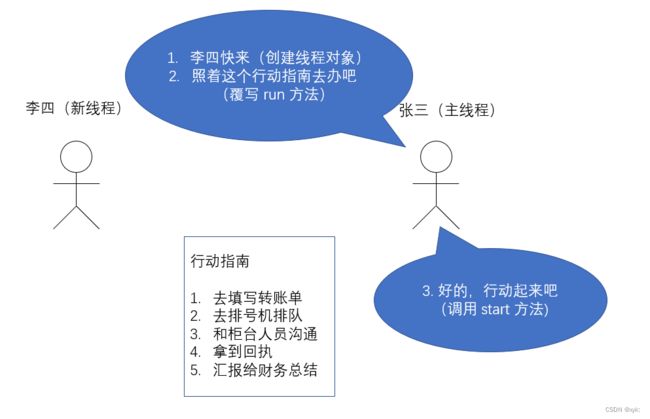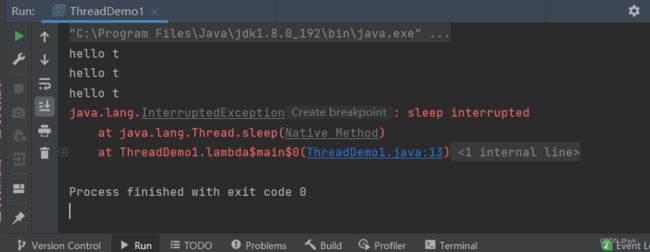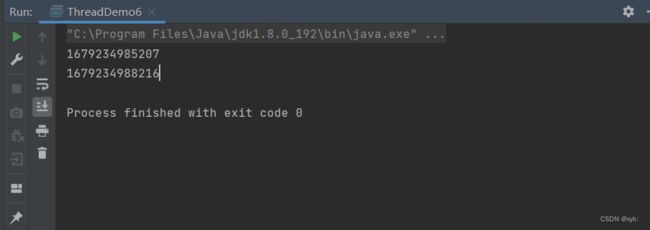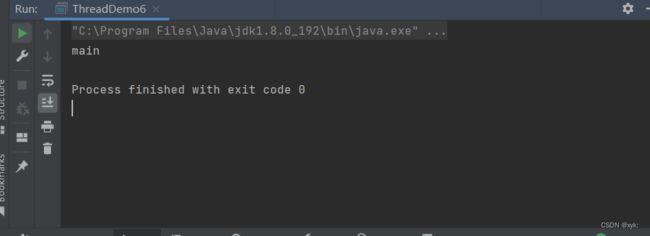到底线程要怎么去编程?线程类有哪些基本用法?
上篇文章我们介绍了到底什么是线程,线程与进程的区别,线程怎么去创建的五种方法,链接如下:
http://t.csdn.cn/dTDjf http://t.csdn.cn/dTDjf
http://t.csdn.cn/dTDjf
那么本篇文章我将来介绍线程Thread类的基本用法,包含线程创建,线程中断,线程等待,线程休眠,获取线程实例
目录
文章目录
一、线程应该怎么编程?
二、线程的创建
三、线程的启动-start()
3.1Thread类中run和start的区别
四、线程的中断
五、线程的等待-join()
六、线程休眠
七、获取线程实例
一、线程应该怎么编程?
线程应该怎么去进行编程?Java中有一个Thread类用来专门对线程编程的类。
Thread 类是 JVM 用来管理线程的一个类,换句话说,每个线程都有一个唯一的 Thread 对象与之关联。
Thread类的对象就是用来描述一个线程执行流的,JVM会将这些Thread对象组织起来,用于线程调度,线程管理。
二、线程的创建
方法1:继承Thread类
public class ThreadDemo { public static void main(String[] args) { Thread t = new MyThread(); t.start(); while (true) { System.out.println("hello main"); } } } class MyThread extends Thread{ @Override public void run() { while (true) { System.out.println("hello world"); } } }
上述代码涉及俩个线程:
1.main方法所对应的线程(一个进程里面至少得有一个线程)也可以成为主线程
2.通过t.start()创建的新的线程
方法二:实现Runnable接口
public class MyRunnable implements Runnable{ @Override public void run() { while (true) { System.out.println("hello,thread"); } } public static void main(String[] args) { MyRunnable runnable = new MyRunnable(); Thread t = new Thread(runnable); t.start(); while (true) { System.out.println("hello main"); } } }第一种写法是使用Thread的run描述线程入口
第二章写法是使用Runnable interface 来描述线程入口
没有本质区别
方法三: 继承Thread,使用匿名内部类
public class ThreadDemo1 { public static void main(String[] args) { Thread t = new Thread(){ @Override public void run(){ while (true){ System.out.println("hello t"+ Thread.currentThread().getName()); try { Thread.sleep(1000); } catch (InterruptedException e) { e.printStackTrace(); } } } }; t.start(); } }
方法四:实现Runnable,使用匿名内部类,内部类(定义在类里面的类)
public class MyRunnable2 { public static void main(String[] args) { Thread t = new Thread(new Runnable() { @Override public void run() { System.out.println("hello t"); try { Thread.sleep(1000); } catch (InterruptedException e) { e.printStackTrace(); } } }); t.start(); } }{ 放到哪里就是针对哪个类创建的匿名内部类
方法五:使用Lambda表达式,最简单直观的方法
lambda表达式的基本写法:()->{ }
public class MyThreadDemo3 { public static void main(String[] args) { Thread t = new Thread(() -> { while (true){ System.out.println("hello t"+Thread.currentThread().getName()); try { Thread.sleep(1000); } catch (InterruptedException e) { e.printStackTrace(); } } }); t.start(); } }
三、线程的启动-start()
之前我们已经看到了如何通过覆写 run 方法创建一个线程对象,但线程对象被创建出来并不意味着线程就开始运行了。
覆写 run 方法是提供给线程要做的事情的指令清单
线程对象可以认为是把 李四、王五叫过来了
而调用 start() 方法,就是喊一声:”行动起来!“,线程才真正独立去执行了。
调用 start 方法, 才真的在操作系统的底层创建出一个线程.
3.1Thread类中run和start的区别
run方法的作用是描述线程具体要执行的任务;start方法的作用是真正的去申请系统线程
run方法是一个类中的普通方法,主动调用和调用普通方法一样,会顺序执行一次;
start调用方法后, start方法内部会调用Java 本地方法(封装了对系统底层的调用)真正的启动线程,并执行run方法中的代码,run 方法执行完成后线程进入销毁阶段。
四、线程的中断
中断一个线程,就是让一个线程停下来,线程的终止,本质上来说,让一个线程终止,就是让该线程的入口方法执行完毕。
目前常见的有以下两种方式:
1. 通过共享的标记来进行沟通
2. 调用 interrupt() 方法来通知
| 方法 | 说明 |
| public void interrupt() | 中断对象关联的线程,如果线程正在阻塞,则以异常方式通知, 否则设置标志位 |
| public static boolean interrupted() |
判断当前线程的中断标志位是否设置,调用后清除标志位 |
| public boolean isInterrupted() |
判断对象关联的线程的标志位是否设置,调用后不清除标志位 |
1、要线程中断,首先要给线程中设定一个结束标志位
这个死循环,导致入口方法无法执行完毕,不能结束线程,那么我们把循环条件用一个变量来控制:
此时要记住,在lambda表达式中只能捕获的变量是final或者”实际final“
下面不是static修饰的外面的局部变量:
当前是使用自己创建的变量来控制循环,Thread类内置了一个标志位,让我们更方便的实现上述效果:
public class ThreadDemo1 { public static void main(String[] args) { Thread t = new Thread(() -> { while (!Thread.currentThread().isInterrupted()){ System.out.println("hello t"); try { Thread.sleep(1000); } catch (InterruptedException e) { e.printStackTrace(); } } }); t.start(); try { Thread.sleep(3000); } catch (InterruptedException e) { e.printStackTrace(); } t.interrupt(); } }为什么会出现异常后还会正常继续执行??
这是因为interrupt方法的作用:
1.设置表示位为true
2.如果该线程正在阻塞中(比如正在执行sleep),此时就是把阻塞状态唤醒,通过抛出异常的方式让sleep立即结束
注意!!!
当sleep被唤醒的时候,sleep会自动的把interrupted标志位给清空(true -> false)这样下次循环就可以正常执行了
如果想让线程结束那么加上一个break
public class ThreadDemo1 {
public static void main(String[] args) {
Thread t = new Thread(() -> {
while (!Thread.currentThread().isInterrupted()){
System.out.println("hello t");
try {
Thread.sleep(1000);
} catch (InterruptedException e) {
e.printStackTrace();
break;
}
}
});
t.start();
try {
Thread.sleep(3000);
} catch (InterruptedException e) {
e.printStackTrace();
}
t.interrupt();
}
}五、线程的等待-join()
线程之间是并发执行的,操作系统对于线程的调度是无序的,无法判断俩个线程谁先执行谁先结束,那么就要通过join方法来使线程来等待
public class ThreadDemo2 {
public static void main(String[] args) throws InterruptedException {
Thread t = new Thread(() -> {
System.out.println("hello t");
});
t.start();
t.join();
System.out.println("hello main");
}
}意思是在main线程中,调用join方法,让main线程等待t先结束,再往下执行
六、线程休眠
也是我们比较熟悉一组方法,有一点要记得,因为线程的调度是不可控的,所以,这个方法只能保证实际休眠时间是大于等于参数设置的休眠时间的
| 方法 | 说明 |
| public static void sleep(long millis) throws InterruptedException | 休眠当前线程 millis 毫秒 |
| public static void sleep(long millis, int nanos) throws InterruptedException |
可以更高精度的休眠 |
public class ThreadDemo6 {
public static void main(String[] args) throws InterruptedException {
System.out.println(System.currentTimeMillis());
Thread.sleep(3 * 1000);
System.out.println(System.currentTimeMillis());
}
}七、获取线程实例
| 方法 | 说明 |
| public static Thread currentThread(); | 返回当前线程对象的引用 |
public class ThreadDemo6 {
public static void main(String[] args) {
Thread thread = Thread.currentThread();
System.out.println(thread.getName());
}
}

